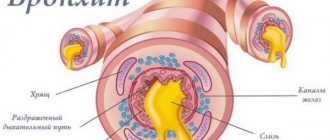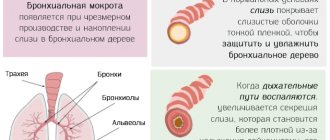Sputum with blood when coughing, in which veins of a reddish-rusty color are observed, may indicate damage to the lung tissue or pathology of the bronchi. Sometimes the cause of this is the rupture of a small blood vessel in the lungs - in this case, this phenomenon does not pose a particular threat to health. But perhaps blood in the sputum signals infectious processes in the lungs. If you feel normal and cough up sputum with rare streaks of blood unsystematically, then there is no reason to suspect serious illness.
If blood in the sputum appears regularly for some time, you need to go to the clinic. If the patient has a history of, for example, chronic bronchitis, then you should not immediately associate the symptom of blood in the sputum only with this disease. The cause of the appearance of blood in the sputum may be a completely different, not yet diagnosed, disease. This symptom is most often found in adults prone to bad habits.
Classification of hemoptysis
Blood in the sputum is a common symptom among patients with respiratory diseases. There are several types of hemoptysis:
- True hemoptysis is the release of blood in the form of streaks, impurities, rusty spots with mucous secretion from the bronchi with a daily volume of up to 50 ml.
- Minor pulmonary hemorrhage is the discharge of blood with sputum or pure blood, often foamy, with a daily volume of up to 100 ml.
- Average pulmonary hemorrhage is the release of blood up to 500 ml of daily volume.
- Large or profuse pulmonary hemorrhage - discharge of more than 500 ml of blood per day.
The sputum may contain traces of blood in the form of streaks, or there may be pulmonary hemorrhage.
Causes of blood in sputum
All causes of expectoration of sputum with blood can be divided into: those accompanied by a cough and those that occur without it.
Sputum with blood without cough
There are situations when blood appears in the sputum without coughing. First you need to determine the source of blood entering the oral cavity. For example, from the lip, tongue, gum, tooth or nasopharynx. The taste of blood in the mouth or blood streaks in the sputum can be observed after medical procedures - bronchoscopy, pulmonary puncture, pulmonary artery catheterization and similar examination methods.
Hemoptysis without signs of cough can occur for completely trivial reasons related to dental problems. Dental pathologies or gum injuries can cause bleeding. Mixing blood with saliva is often mistaken for pathological inclusions in mucus. Such symptoms are also caused by recent hemorrhages in the nasal cavity, penetrating into the oral cavity, and expectorating with sputum for several days.
Such symptoms are typical for vascular tear of the aorta, as well as during medical procedures; such procedures provoke minor hemorrhage and do not require treatment. But there are situations when hemoptysis without cough can be a consequence of internal pathologies. The cause may be infectious processes in the respiratory system, a blood clot in the lung, oncological pathology, or problems with hemostasis (blood clotting).
The most common cause is cardiogenic pulmonary edema, manifested by weakness and pain in the chest area, and a slight discharge of bright scarlet foamy sputum. Cases of mortality are common. In any such case, a qualified examination is necessary.
Why is there blood in my sputum in the morning?
The manifestation of hemoptisis in the morning often indicates long-term functional disorders in the body associated with:
- With inflammatory or tumor processes in the lung tissue;
- The development of cellular allergies and granulomas of a specific nature in various organs and systems of the body caused by tuberculosis bacteria;
- Hemorrhagic diathesis;
- Vascular aneurysm or varicose veins;
- Pathologies of the nasopharynx and tonsils.
Sputum with blood when coughing
It can even be caused by excessive use of blood thinners. For example, Aspirin. It makes the blood vessels more fragile and with the slightest expectoration, both streaks of blood and liquid blood may appear from the mouth. But, most often, the causes of this pathology are still inflammatory and infectious diseases of the respiratory system, various tumors and other diseases of the internal organs.
A cough can be caused by an allergy (this is indirectly indicated by an increase in the level of eosinophils in a general blood test) - an antiallergic drug is needed
Coughing up blood with a cold
A cold can manifest itself with various symptoms - fever, feeling unwell, and so on. If this disease is not treated in time, it will become protracted. A dry cough appears first without fever, then turns into a wet one. If this is not treated, then quite serious complications await. Such as pneumonia, abscess and COPD.
So can you cough up blood when you have a cold? Unfortunately, it's rare, but it can happen. Why is this happening? During a coughing attack, especially dry coughing, there is a strong tension in the smooth muscles of the larynx. This can cause a small rupture of small vessels and veins. In this case, the sputum will contain a small amount of scarlet blood streaks.
If you are suffering from acute respiratory infections, flu or bronchitis with prolonged red discharge, then this is already a sign of more serious diseases. You should tell your doctor about this, who will refer you for additional examination.
Diagnosis of the causes of coughing up blood
As already mentioned, the appearance of blood-streaked sputum can be caused by numerous diseases, although the most common is inflammation, which occurs from a common upper respiratory tract infection.
But a large number of other diseases can also lead to the appearance of blood in sputum:
- Sinusitis. Inflammation of the paranasal sinuses, as a result of the accumulation of mucus in the paranasal sinuses and nasal passages, in which an infectious process of viral and/or bacterial etiology is actively developing.
- Laryngitis. Inflammation of the larynx of viral etiology, less often bacterial (streptococci and Haemophilus influenzae).
- Pharyngitis. Inflammation of the pharynx caused by viruses such as adenovirus or Epstein-Barr virus and/or bacteria such as streptococci.
- Acute bronchitis. Inflammation of the mucous membrane of the bronchial tree, caused in 90% of cases by viruses (adenoviruses, influenza-like viruses, coronavirus, rhinovirus, etc.) and in 10% by bacteria (streptococci, Haemophilus influenzae, Bordetella pertussis, etc.).
- Chronic obstructive pulmonary disease. Degeneration of the pulmonary and bronchial tissues of a chronic nature, which impedes the transit of inhaled air. Cigarette smoking and air pollution are some of the main causes of this disease.
- Pneumonia. Inflammation of the alveoli of the lungs caused by viruses, bacteria, fungi or parasites.
- Tuberculosis. Infection of the lungs with Mycobacterium tuberculosis.
- Wegener's granulomatosis. Inflammation of small vessels of the upper respiratory tract of an autoimmune nature.
- Fibrosis (cystic fibrosis). A genetic disease leading to a deficiency of the CFTR protein, which is responsible for chlorine translocation. Which leads to the accumulation of fluids in vital organs such as the lungs and pancreas.
- Lungs' cancer. Formation of tumor cells in the lungs.
- Mitral stenosis. Pathological narrowing of the valve that separates the left atrium from the left ventricle. Mitral stenosis causes bleeding from the small vessels of the lungs and, consequently, the appearance of sputum streaked with blood.
- Pulmonary embolism. This term defines a condition where one of the two pulmonary arteries is blocked by a thrombus or blood clot. This condition is characterized by a cough with phlegm and blood stains.
- Lung abscess. Purulent process in the lung parenchyma.
- Use of certain illicit drugs such as cocaine and crack.
https://www.youtube.com/watch?v=sJ_h4oF9eCg
In 90% of cases, people who do not have specialized medical education perceive blood when coughing as something terrible.
In real life, the appearance of blood streaks in sputum is sometimes almost physiological. The assessment of the danger of a situation to human health is carried out depending on the surrounding circumstances.
Diseases characterized by the appearance of blood in sputum
Pathological conditions in which there is a symptom of blood in the sputum or coughing up blood:
- Bronchitis. Prolonged cough with sputum. The sputum contains bright scarlet speckles of blood along with pus. High temperature, shortness of breath.
- Pneumonia. “Rusty” sputum interspersed with scarlet blood is coughed up. Shortness of breath, weakness, high temperature.
- Lung abscess. Persistently elevated temperature, night sweats, chest pain, poor appetite. The sputum is purulent, fetid, interspersed with blood.
- Bronchiectasis. The cough is prolonged and there is pus in the sputum. Shortness of breath, fever, weakness.
- Tuberculosis. Persistent low-grade fever, weight loss, lethargy, poor appetite, purulent sputum with traces of blood.
- Lungs' cancer. Scarlet streaks in the sputum, prolonged cough, sudden weight loss, feeling of suffocation, severe sweating at night, chest pain.
- Cardiac disorders. Blood stagnation, shortness of breath during exercise, cough with traces of blood.
- Pulmonary embolism. Severe pain in the chest, a couple of hours after the onset of pain - coughing up blood.
- Respiratory cystic fibrosis. Frequent colds. When coughing, purulent, viscous sputum with traces of blood is produced.
- Diseases of the stomach, esophagus, duodenum. Instead of coughing up blood, there is bloody vomiting. It is important to distinguish these phenomena from each other. When vomiting, blood is released in dark red clots.
- Pathologies of traumatic origin (after biopsy, bronchoscopy, after operations). A cough with scarlet blood appears after operations or traumatic diagnostic procedures.
Pathological conditions in which blood is observed in saliva:
- Dehydration of the body.
- Hypothyroidism.
- Bronchitis.
- Lungs' cancer.
- Tuberculosis.
- Pneumonia.
Bloody sputum in tuberculosis
Coughing up blood is a common symptom of active TB. This is one of the most difficult to treat infectious lung diseases. Every year the number of tuberculosis patients increases. More than 4 million people die from this disease every year. The causative agents of tuberculosis are mycobacteria. These are intracellular microorganisms that are highly resistant to environmental factors and many antibacterial drugs.
About 2 billion people worldwide are infected with mycobacteria. If the immune system is sufficiently strong, the disease does not occur. Predisposing factors for the development of tuberculosis are smoking, hypothermia, stress, alcoholism, diabetes mellitus, chronic heart disease, hypovitaminosis, and HIV infection.
Pulmonary tuberculosis is characterized by the following symptoms:
- cough with sputum;
- slight increase in body temperature;
- runny nose;
- wheezing in the lungs;
- enlarged lymph nodes;
- night sweats;
- weakness;
- apathy.
With tuberculosis, sputum with streaks of blood comes out. It may be purulent. This often happens in the morning. Hemoptysis most often occurs in the later stages of the disease. Frequent bleeding can cause anemia. Tuberculosis is a contagious disease. It can be transmitted through airborne droplets, which is why it is so important to consult a doctor promptly.
Worm infestation
If a child or adult has helminths in the body, blood may be released from the lungs along with sputum. There are a huge variety of helminths. They can live and reproduce in almost all organs (liver, gall bladder, brain, heart, lungs). Most often, sputum with blood is expectorated with the following parasitic diseases:
- Paragonimiasis;
- Strongyloidiasis;
- Echinococcosis;
- Hookworm;
- Trichinosis;
- Ascariasis.
Roundworms live in the intestinal lumen, but under unfavorable conditions they can migrate through the lungs, causing injury to the organ. Human infection with parasites can occur through the fecal-oral mechanism (by consuming poorly washed foods or contaminated water), or by contact (through the skin). Cough with helminthiasis is most often dry. Additional symptoms of a parasitic infection may include weight loss, nausea, abdominal pain, wheezing in the lungs, headache, and vomiting. Cough often bothers sick people in the morning.
Pneumonia
Pneumonia may produce blood when coughing. Most often this happens if the causative agents of the disease are staphylococci, legionella, and pseudomonads. Pneumonia is an acute inflammation of the lung tissue. In most cases, the disease is infectious in nature. The prevalence of the disease among the population is 10-15 cases per 100 thousand people. Children often suffer. Pneumonia is dangerous due to its possible complications. It often leads to the death of the patient. The appearance of blood in the sputum is most typical for lobar pneumonia.
Taking medications to treat the disease The main symptoms of this form of pneumonia are: cough, high temperature (up to 40 degrees and above), weakness, shortness of breath, chest pain. At first the cough is dry, then it becomes productive. In this case, sputum streaked with blood is released. Sputum brick, rusty color. Symptoms of the disease may bother a person for 1-2 weeks. With pneumonia, both a segment of the lung and a lobe may be involved in the process. Total inflammation often develops. Pneumonia can lead to the following complications: abscess formation, lung gangrene, respiratory failure, endocarditis, myocarditis.
Sputum analysis is very important for diagnosis. If there is an infectious process, various bacteria can be found in the sputum. If tuberculosis is suspected, a Mantoux test and a Diaskin test are performed.
Bloody sputum in cancer
Hemoptysis is one of the signs of lung cancer. This is the most dangerous pathology. Like any other malignant tumors, lung cancer occurs in several stages. The effectiveness of treatment largely depends on the timely diagnosis of the disease. Predisposing factors for the development of lung cancer are the following:
- smoking (passive and active);
- burdened heredity;
- the presence of chronic pathology of the lung tissue and bronchi;
- endocrine disorders;
- harmful working conditions (contact with asbestos, inhalation of dust);
- contact with harmful chemical compounds (arsenic, salts of heavy metals);
- work at enterprises producing rubber and coal mining.
Lung cancer develops more often in men. Ambient air pollution is also important. Lung cancer is characterized by the following symptoms:
- cough;
- loss of body weight;
- increased sweating;
- weakness;
- shortness of breath.
Hemoptysis in cancer is very common. Blood may be mixed with sputum. Sometimes foamy scarlet blood is released. If the blood is fresh, it has a bright red color. Coagulated blood is released in the form of clots. At the same time, mucus may be detected in the sputum. The cough of such patients is painful and annoying. As the disease progresses, symptoms intensify. Often hemoptysis is combined with shortness of breath. If peripheral lung cancer develops, there may be no symptoms.
Causes of coughing with phlegm and blood
In most cases, blood in the sputum when coughing is a sign of damage to the respiratory system. This symptom can be accompanied by various serious pathologies that pose a threat to human life and health. There can be several reasons for coughing with phlegm and blood, the main ones are the following:
- Lungs' cancer. This disease is most often detected in people who have been coughing up blood for a long time. During tumor processes in the lungs, scarlet streaks of blood may appear in the sputum. Other symptoms of this pathology include significant weight loss, chest pain, shortness of breath, a feeling of lack of oxygen, a prolonged painful cough, severe night sweats, and others. The most susceptible to this disease are people who smoke for a long time, as well as those who work in production with constant air pollution, for example, in the cement industry.
- Acute bronchitis. With a strong cough, small single streaks of blood may appear in the sputum. In addition, bronchitis is characterized by symptoms such as fever, weakness, severe cough with sputum, sometimes purulent, shortness of breath and others.
- Lung abscesses, which are the formation of cavities in the lung tissue filled with purulent contents. An abscess usually develops in people with weakened immune systems. Signs of this disease include chest pain, fever that persists for a long time, bouts of night sweats, general malaise, disturbance of normal sleep and appetite, as well as a cough that produces a large amount of sputum with the presence of pus and blood streaks.
- Bronchiectasis. With this pathology, there may be weakness, shortness of breath, and a possible rise in temperature. It is accompanied by a prolonged, frequent cough with purulent sputum and blood.
- Inflammation of the lungs, or pneumonia. Typical symptoms of the disease are chest pain, a significant increase in temperature, severe shortness of breath, and a sharp, repeated cough, which can produce a large amount of sputum with traces of fresh blood. The color of the sputum itself may be “rusty” due to clotted blood.
- Tuberculosis. It is manifested by a decrease in body weight, loss of appetite, a constant slight increase in temperature to approximately 37.5 degrees, constant bouts of coughing with the discharge of sputum, which may contain pus and streaks of blood. The appearance of a large amount of fresh blood in the sputum when coughing is an unfavorable diagnostic sign.
- Pulmonary embolism. When an embolism occurs, the lumen of the pulmonary artery becomes blocked. People are more prone to developing this pathology after surgical operations, such as treatment of thrombophlebitis of the leg veins. Signs of the disease include shortness of breath, sudden severe pain in the space behind the sternum, and coughing up blood occurs several hours after the first symptoms.
- Damage and developmental pathologies of heart valves and other similar heart diseases. With such diseases, normal blood circulation is disrupted, which leads to congestion in the lungs. Symptoms of heart pathologies include severe shortness of breath, which worsens with physical activity, and a cough with sputum and traces of blood.
- Cystic fibrosis. This pathology is characterized by changes in the functioning of the glands and is inherited. Respiratory cystic fibrosis, accompanied by damage to the respiratory system, is manifested by symptoms such as cough with thick sputum, which contains pus and streaks of blood, frequent colds, and the infection quickly descends to the lower parts of the respiratory system.
- External factors. Coughing up blood may occur after certain diagnostic procedures, such as biopsy, bronchoscopy, and chest surgery. It is possible that traces of blood may appear in the sputum after taking certain medications.
- Pathologies of the digestive organs. It is a fairly rare case that vomiting blood or bleeding in the esophagus, stomach or upper intestines is mistaken for bleeding from the lungs. In diseases of the digestive tract, blood usually comes out in the form of clots, in large quantities, and its color is dark red.
When should you see a doctor?
The appearance of the following symptoms indicates the presence of a serious illness and requires immediate medical attention:
- Cough with copious discharge of blood;
- Weakness, weight loss, lack of appetite;
- Prolonged cough in smokers;
- Dyspnea (feeling of lack of air) that occurs at rest;
- The appearance of severe chest pain.
In rare cases, pulmonary hemorrhage may occur against the background of tuberculosis or lung cancer. If there is copious discharge of scarlet blood with foam, the person must be placed in a semi-sitting position and immediately call emergency medical help. All blood that comes out must be coughed out and not retained inside.
If blood appears in your sputum, be sure to consult your doctor:
- A therapist.
- Pulmonologist.
- Phthisiatrician.
- Oncologist.
Blood in the sputum when coughing is a serious symptom of serious illnesses. If you observe such a terrible phenomenon in yourself or your loved ones, you should not hesitate to visit a doctor. Timely treatment will help preserve health, and in some cases, life.
Sputum with blood in bronchitis
The presence of blood in the sputum during a cough often indicates the presence of serious diseases associated with the respiratory system. Such a disease is chronic bronchitis, which occurs in an acute form. To establish the exact cause, it is necessary to know the symptoms characteristic of this disease.
In acute bronchitis, there is a wet cough. Sometimes, traces of blood can be seen in the sputum, and the patient’s temperature rises. Chronic bronchitis is characterized by a prolonged cough that lasts for more than three months. Shortness of breath occurs during physical activity.
At a time when chronic bronchitis worsens, in the sputum, in addition to thick purulent discharge, there are scarlet streaks of blood. Therefore, only after a comprehensive examination, a course of therapy aimed at eliminating the cause of the disease is prescribed.
Diagnostic measures
Treatment is carried out only after the underlying cause of the appearance of blood in the sputum has been established. Diagnostics includes:
- interviewing the patient and collecting anamnesis;
- general blood and urine analysis;
- examination of the mouth and throat;
- conducting FGDS;
- X-ray examination of the lungs;
- CT or MRI;
- bronchoscopy;
- microscopic examination of sputum for the presence of bacteria;
- conducting an ECG;
- listening to the lungs;
- measuring temperature, pressure, pulse.
These studies can detect whether a person is infected. Sometimes the patient's sweat may be examined. This is observed when cystic fibrosis is suspected. If at the same time blood comes out of the nose periodically, blood diseases should be excluded.
With this symptom, in almost 10% of patients, the diagnosis does not always “work” even with a thorough and lengthy examination, which forces the patient to repeat the research process after two weeks. And almost half of the patients who failed to establish a diagnosis turned out to be “ardent smokers.” After the initial examination, if the doctor identifies alarming symptoms, he will give a referral for examination to more specialized specialists.
Treatment of the disease
Treatment depends on the underlying disease. If streaks of blood in the sputum are detected in acute bronchitis, treatment involves: rest, drinking plenty of fluids, using mucolytics, expectorants, and NSAIDs. To liquefy and improve the discharge of sputum, the following agents are used: Lazolvan, Bromhexine, Ambrobene, thermopsis infusion, marshmallow root infusion. If your chest hurts, warm compresses can be used. Physiotherapy is widely used. In case of bronchial obstruction, bronchodilators are indicated. For bronchitis due to a viral infection, antiviral drugs (Remantadine, Interferon) are prescribed.
Symptomatic therapy includes taking bronchodilators (Eufillin, Berotek, Salbutamol), mucolytics, and expectorants. If a cancerous tumor is detected at an early stage, surgical treatment is performed. After surgery, radiation and drug therapy may be provided. Chemotherapy is used if surgery is not possible for the patient. In later stages, in the presence of metastases, palliative therapy is organized in other organs. It is aimed at prolonging the life of the patient. Thus, the appearance of blood in the sputum is a reason to consult a doctor.
Pulmonary hemorrhage and first aid
If a person begins to produce copious amounts of bloody foam from the mouth, this is an emergency condition, the so-called pulmonary hemorrhage. It is necessary to hospitalize the patient without delay. First of all, call an ambulance. Pulmonary hemorrhage can occur with tuberculosis or lung cancer.
It is necessary to help the patient take a half-sitting position and allow him to swallow some ice. Raise the patient's head. Any blood that comes out must be coughed up immediately and under no circumstances should it be retained inside. The patient should not be allowed to swallow blood. The danger of pulmonary hemorrhage is that blood can get into the deep layers of the lung tissue, and this causes a serious pathology - aspiration pneumonia.
Causes
Hemoptysis may indicate the formation of malignant tumors. Other reasons include:
- thromboembolism of pulmonary vessels;
- mitral valve stenosis;
- the left ventricle does not function sufficiently;
- Eisenmenger syndrome;
- abnormal development of veins and arteries; pulmonary vasculitis;
- hemorrhagic diathesis;
- Goodpasture's syndrome.
Blood may be released in the mucus in the presence of an inflammatory process, injury to the lung, bruises, or ingestion of foreign bodies. Coughing up blood may occur with metastatic lung carcinoma, viral or pneumococcal pneumonia. Streaks of blood in sputum when coughing can appear in other dangerous diseases.
If sputum is coughed up with blood (there are streaks of red-rusty color), this means that a small blood vessel has ruptured in the lungs. This does not in any way affect the person’s functioning or the progress of their recovery. This sign is a signal of a lung infection, but only if blood is not constantly released. If this happens regularly, contact a specialist as soon as possible.
Immediately after waking up, bloody sputum appears for various physiological reasons, and is one of the signs of a dangerous disease. For example, this may indicate rupture of the bronchial vessels, which occurs with a violent, violent cough. The vessels themselves are very fragile, especially when treated with certain drugs. The blood comes out in small clots and will disappear in a few days.
If you notice a large amount of blood when you cough up in the morning, this indicates that you may have tuberculosis. He is summoned by Koch's wand. Symptoms: hacking cough, high fever, bloody sputum. Tuberculosis is detected using fluorography. The next reason is lung cancer, which is the most dangerous disease. In cancer there are:
- dyspnea;
- sore throat;
- painful cough;
- weight loss, appetite;
- temperature increase;
- hemoptysis.
The cause is a great addiction to nicotine products (cigarettes), so smokers suffer from a cough in the morning. If blood appears in the sputum in the morning, there is a high probability of a pulmonary infarction. A prolonged, profuse cough may occur. Patients experience chest pain, difficulty breathing, and shortness of breath.
During illness, the body tries to overcome the disease, which is why a fever appears. Coughing helps remove harmful bodies and excess mucus from the airways. The reasons for the release of bloody sputum during a cough can be different; only a doctor can determine the disease. For example, such a symptom may be a sign of an allergic reaction. Another reason may be a malfunction of the cardiovascular system.
The presence of mucus in the hollow organs of the pulmonary alveoli can cause throat irritation. It can lead to pulmonary embolism. Another reason may be sexually transmitted diseases or smoking. The body tries to get rid of nicotine tars that settle on the walls of the respiratory organs. A cough with impurities occurs when:
- pulmonary edema;
- pneumonia
- chronic bronchitis;
- lung abscess;
- tuberculosis;
- bronchial asthma.
For a cold
Symptoms of colds in the respiratory tract are often the production of sputum from the bronchial mucosa. It has a clear or milky color and bubbles. If blood clots get on it, the sputum turns pink, and sometimes there is a dark red color of the sputum. The cause of bleeding is inflammation of the throat. The walls of the throat swell. Vessels can burst due to a strong, sharp cough. It is not hazardous to health and no medical intervention is required.
If purulent sputum appears, you should pay attention to this. Purulent discharge appears in patients who have already had pneumonia or pneumonia. After the mentioned diseases, the human immune system is greatly weakened. He does not always cope with his defensive reaction, so if you notice that during a cough there are traces of pus or blood clots are released, contact your primary care physician.
For bronchitis
During a cough with bronchitis, red streaks can be observed. They can be found in a thick mucous mass that is released during a prolonged cough. Bronchitis is characterized by inflammation of the bronchial mucosa. The illness does not last long, but is accompanied by high fever and frequent suffocating cough.
Bronchitis is manifested by bright spots or streaks of scarlet blood, and there are clots of pus. To the symptoms of stagnation of sputum in the lungs, several more are added: shortness of breath occurs, general weakness is noted. The disease can be detected using bronchoscopy. Bronchitis can be confused with cystic fibrosis, the pathology of which is caused by a mutation of the cystic fibrosis gene, which disrupts the structure and function of cells that synthesize protein, which is why thick saliva and a cough with the taste of blood are observed.
For pneumonia
Inflammation of the lungs or pneumonia is accompanied by a cough with sputum, foamy blood is released. The acute form is characterized by severe shortness of breath with sputum and streaks of blood. At the same time, you may notice a deterioration in the patient’s general condition, a dull cough, and chest pain. Expectoration is accompanied by the release of reddish mucus and saliva. Purulent abscesses may be observed. A small purulent plaque accumulates in the oral cavity, and an unpleasant odor is noticeable.
During pregnancy
There are cases when during pregnancy a cough is bothersome with blood streaks, which is a consequence of rupture of a small bronchial vessel during coughing, possible mental trauma or heavy workload. Streaks of brown or reddish-rusty phlegm can be observed for several days, and then disappear altogether. In case of an inflammatory process, pus in blood sputum, it is recommended to immediately consult your doctor.
- With inflammation of the bronchi, hemoptysis appears in 65% of cases. Acute or chronic bronchitis is characterized by frequent and severe coughing attacks. This is when blood streaks appear, mainly in the morning hours.
- The appearance of bright scarlet blood in the sputum is characteristic of pneumonia or a lung abscess. At the same time, the temperature rises, weakness sets in, and immunity decreases.
- A small amount of blood in the sputum is observed with laryngitis, tracheitis and tonsillitis.
- Tuberculosis is characterized by a prolonged cough, during which small amounts of sputum are released. It has a pink color or red veins.
- With lung cancer, clinical manifestations are not observed for a long time. But, after a certain time, the patient develops a cough that repeats in attacks. At the same time, streaks or blood clots appear in the sputum. The patient's condition deteriorates sharply.
- Decompensation in cardiovascular diseases often leads to the development of pulmonary hypertension. Because of this, blood stagnates in the lungs, after which it appears in the sputum during coughing.
- Pulmonary hemorrhage poses a serious threat to life for the patient. As a result, heavy bleeding occurs during coughing, accompanied by shortness of breath and chest pain. In such cases, urgent hospitalization is required.
Blood in sputum is quite often a symptom of respiratory diseases. The following types of hemoptysis are distinguished:
- profuse;
- middle pulmonary;
- small pulmonary;
- true.
The causes of cough accompanied by blood are varied. This condition can occur with the following lung diseases:
- hemosiderosis;
- silicosis;
- opening and closed lung injuries;
- parasitic diseases;
- abscess;
- pulmonary infarction;
- pneumonia;
- tuberculosis;
- central lung cancer.
The causes of hemoptysis may be hidden in diseases of the bronchi. This may be acute bronchitis or bronchiectasis. Other possible causes: cystic fibrosis, endometriosis, sarcoidosis, hemophilia, leukemia, systemic lupus erythematosus, mitral valve stenosis.
Blood can enter the sputum from the mouth or throat. The cause in this case is a tongue injury or bleeding gums. Sometimes expectoration of bloody sputum may be associated with medical procedures (surgery, bronchoscopy, biopsy).
Streaks of blood in sputum may not always indicate a disease. This condition can occur as a result of a simple rupture of small vessels, which quite often occurs with a strong cough. Also, such sputum is detected during the use of certain medications (anticoagulants).
The cause of bloody sputum when coughing is often an active form of tuberculosis. This kind of infectious lung disease is very difficult to cure. The number of tuberculosis patients increases every year. The causative agents of this disease are mycobacteria, which are intracellular microorganisms that are quite resistant to many antibacterial drugs.
According to statistics, about two billion people around the world are infected with such bacteria. With strong immunity, this disease usually does not occur. Tuberculosis is usually provoked by the following factors: hypovitaminosis, chronic heart pathologies, diabetes mellitus, alcoholism, stress, hypothermia, smoking, HIV infection.
Signs of tuberculosis:
- weakness;
- night sweats;
- enlarged lymph nodes;
- wheezing in the lungs;
- runny nose;
- slight increase in body temperature;
- cough with phlegm;
- apathy.
With tuberculosis, sputum may contain not only blood, but also pus. Expectoration of blood occurs most often in the later stages of the disease. With frequent bleeding, anemia develops. Tuberculosis is a contagious disease that can be transmitted by airborne droplets.
Worm infestation
Expectoration of sputum with blood can occur in the presence of helminths, which can live and multiply in almost all internal organs (lungs, heart, brain, gall bladder, liver). Quite often, sputum with blood is expectorated with parasitic diseases such as:
- ascariasis;
- trichinosis;
- hookworm;
- echinococcosis;
- strongyloidiasis;
- paragonimiasis.
Preventing the appearance of blood in sputum
General preventive measures are:
- healthy lifestyle, moderate physical activity, frequent exposure to fresh air;
- rational balanced diet, rich in vitamins and microelements;
- strengthening the immune system, hardening, preventing colds;
- quitting or reducing smoking;
- restriction of visiting crowded places during epidemics of viral diseases;
- regular spa treatment for those suffering from chronic diseases of the bronchopulmonary system;
- treating a cold at its first symptoms, preventing complications;
- To prevent pulmonary hemorrhage, it is necessary to promptly identify and treat diseases against which it can develop, and control blood clotting.
In a number of diseases, most often the respiratory system, a cough may be accompanied by a small or copious discharge of blood - liquid, in the form of small patches or clots. If sputum with blood during a cold is observed repeatedly, you need to consult a doctor and undergo an examination in order to promptly identify complications. Treatment of hemoptysis depends on the causes that caused it, and a healthy lifestyle, strengthening the immune system, preventing colds and timely treatment of other diseases are the best prevention.










